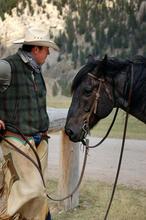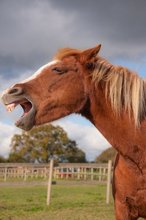Ways in which horses use language
Equines "talk" with each other all the time. Using a language unique to their species, they constantly use facial, vocal and body signals to communicate with each other, and, because these signals are the only language they know, they use the same language to communicate with humans.
Understanding the basics of equine language is extremely important in accurately assessing what is happening with the horse and how it perceives you and the world around it.
Equine language intersects closely with the senses: hearing, sight, smells, touch, and taste. Based on use of their senses, horses then react to their perceptions through movement of facial features, body and limbs, and vocal signals.
Facial feature language
Watch any horse carefully and you will be surprised at how much information the position, movements, and facial expressions convey, not only to other horses, but also to humans.
The horse's ears constantly give clues about where the horse's attention is focused and how it is interpreting what is happening:
- Neutral and relaxed: comfortable with its surroundings
- Pointing up and forward: curious, attentive and observant of what is happening up front
- Rigid and pointing up: fear and uncertainty
- Pinned back: angry, aggressive and threatening, or, if more relaxed, possibly just listening to what's happening behind it
- Rotating: curious, nervous and indecisive because of so much sensory information
- Each ear focused in a different direction: paying attention to two things at once
The horse's eyes do much to convey a wide range of emotions. Horses may be feeling worried, curious,kind, gentle or fearful. These are some of the indicators that will help you understand your horse better:
- Blinking: processing information and thinking
- Soft eye: gentle and relaxed; learning mode
- Hard eye: tense and resistant
- Whites of eyes showing: fear and panic
- Wrinkled: worried, trying to figure out what is happening
- Half closed: tired, relaxed, sleeping
The horse's muzzle, lips, nostrils and nose signal emotions, needs, and state of mind. The following are indicators of the horse's state of mind as it takes in happenings around it:
- Tight hard lips and mouth: anxious, tense fearful or mildly angry
- Wrinkled muzzle: nervous, worried
- Teeth exposed: aggressive and ready to bite
- Drooping lip and saggy mouth: relaxed, bored, exhausted; if coupled with flared nostrils shows pain
- Licking and chewing: stress release, digesting ideas, observing
- Nostrils elongated usually combined with teeth exposed: watch out
- Extended wiggling nose: shows intention to search pockets or engage in mutual grooming
- Nose wrinkling: sign of annoyance, pain; with ears back indicates mild threat
- Relaxed nostrils and soft muzzle: neutral, relaxed
- Flapping lower lip: Unfocused, sensitive, nervous
- Mouthing in case of foals: shows submission
Body language
The tail is used as a visual signal in many cases including:
- Flagged: excited, happy, playful, alarmed
- High-tailing: used by mares to attract stallion, but then combined with lower head carriage and drooping ears so as not to be mistaken for a startle position
- Tail swishing and lashing: annoyance, irritation, frustration, conflict, flies
- Tail flattening: fear, submission
- Neutral or level: focused, normal
Head and neck set are important in recognizing the attitude of your horse:
- High: fearful, anxious, defiant, alert
- Low: relaxed, accepting
- Level: neutral, focused
The way a horse is using its legs reveals a great deal about its inner state of mind:
- Dancing around: nervous, excited, frightened
- Hind hoof resting: relaxed
- Hind leg lifted: warning, defensive
- Pawing: frustrated
- Standing square: attentive
- Stamping: mild irritation, flies
- Striking: angry, threatening, fighting
Vocal signals
Horses have a wide range of vocal signals which they have used to their advantage down through history. Following are some of the important vocal signals horses use:
- Neigh: contact or recognition
- Nickers: depends on relationship: a stallion's courtship nicker; maternal nicker of mare to foal; friendship nicker to human with food
- Squeal: very close contact, especially sexual
- Snort: alarm, challenge excitement
- Screams and roars: extreme emotional state, rage, fear. If a horse screams or roars at you, get out of the way. It really means to hurt you. (Very rare)
- Grunts: effort, fighting, jumping; in cases of pain or colic, not an intentional signal
- High blowing noise made in false nostril: sign of pleasure especially when cantering
- Nose blowing or clearing: relaxed, happy with environment or work
Use of smell
The way a horse smells things is also an indication of mood and attitude and a horse uses smell as a tool of recognition. Horses greet each other by smelling, and shake hands by sniffing noses. Horses smell people, objects, and food to determine whether, good, friendly, or obnoxious. They also sniff and smell things they are fearful about.
Touch
Horses are also very sensitive to touch and are capable of feeling pleasure, pressure, pain, temperature. Their faces and bellies are especially sensitive. Horses enjoy being scratched and stroked, and once they are accustomed to being groomed, derive much pleasure from the touch of brushes and hands in the grooming process.
Taste
Taste is not as important to horses as the other senses, but it is well developed. They enjoy a variety of treats that can be used to elicit the wanted behaviors during training.
You may be amazed at how well a piece of carrot or apple works in gaining your horses cooperation. Since they love the taste of grain and other feeds, care has to be taken to insure that they don't make themselves ill by over eating when given a chance.
Consider this
By being alert to your horse's facial, vocal and body language signals, understanding and communicating with your horse will take on new and effective dimensions.

Horse body language
Learning to speak with your body language and read that of your equine will improve your safety and security.
Body signals can give you invaluable information about your horse and its perception of the world around it. If a horse is striking out, head tossing, bucking or rearing, you immediately know that the animal is defiant, aggressive, frustrated or confused. If these actions occur with a rider in the saddle, it means the horse isn't listening, is receiving mixed signals, or simply is not willing to cooperate.
As you approach your horse each time, make a mental note of whether its body and muscles are tensed or relaxed. Look at the tail, the neck and the withers and their positions in relationship to the rest of the body.
Note how the horse is breathing. Is it relaxed, labored or is the horse holding its breath? By looking at the horse's stance and noting body, facial, and vocal signals, you will have the key to your horse's state of mind.

